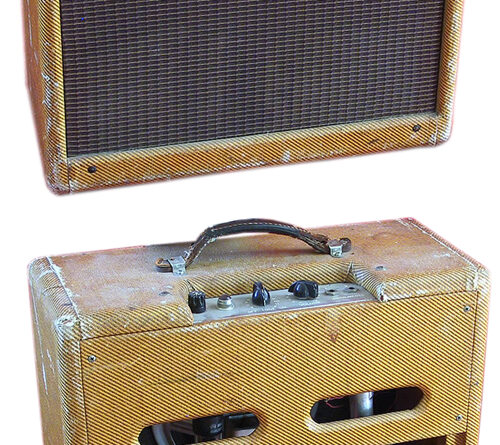Fender Narrow Panel Tweed Princeton
Model/Circuit Number: 5E2, 5F2, 5F2-A
Years of Production: 1955 – 1960
Era: Narrow Panel
Configuration: Combo
Controls: Chrome top facing w/ white screened labels, controls numbered 1-12
Knobs: Black Chicken Head
Schematics
Faceplate
- Front: 5E2, 5F2: Fuse (2A), Pilot Lamp, Tone/Power Sw, Vol, In, In ; 5F2-A: Fuse(¾A), Power Sw, Pilot Lamp, Tone, Vol, In, In
- Rear:
Cabinet
- Dimensions: Narrow Panel: 1955: 12½” x 13½” x 8”, 1955-1960: 16¾” x 18” x 8¾”
- Hardware: None
- Handle: Leather Handle
- Feet: Glides
- Corners: None
Covering Material
- Tolex/Tweed: Diagonal Tweed
- Grill Cloth: Brown Grill Cloth
Logo: Cabinet mounted, Script
Weight:
Speaker
- Size: 1 x 8
- Impedance:
- Model: Jensen P8T, Oxford 8EV or Cleveland 8(For more info, check out the Jensen Replacement Speakers)
Effects:
~Watts: 4 1/2 watts
Tubes
- Pre amp: 12AX7
- Power: 6V6GT (single ended)
Bias: Cathode Bias
Rectifier: 5Y3GT
Comments: Model 5E2: The Princeton circuit gained a filter choke and a negative feedback loop. Model 5F2-A: The filter choke is removed from the circuit. The speaker jack is located on the bottom of the chassis.


I have a handbuilt clone of this amplifier, where the builder selected each component by hand and built it to exacting specs (with the exception of a 12″ alnico blue in a deluxe size cabinet) and it is more than enough at rehearsals to do the Neil Young, Steve Earle, old school gritty blues rock and country sounds that you would expect from a nice old tweed amplifier. I carry this, an xotic ep booster and a guitar in and I’m ready to go.
That’s so funny. I have a 1958 tweed Princeton and all I use is the xotic ep boost. Really gives it the punch it needs.
Indeed the clean boost is a great match with the little Tweeds….I like to have a reverb too for cleaner tones.
I have an EP-Pre by ClinchFX (mimics old tape delay pre-amp) I love for just a few dB’s. I also have the good old xotic EP Boost. I have been using Andy Fuchs’ Plush reverb pedal after dismissing attempts like VanAmps reverbmate and the Boss FRV-1. My budget doesnt allow the authentic Fender analog unit.
I’m building a clone of this amp right now. I’m using an Eminence Rajin’ Cajun’ speaker. Should be a good sounding little unit. All components are top-shelf, Mil-spec.
I have a 1960 Princeton and you simply can’t say enough about these things. I had a 1960 Champ which was a lot of fun but the Princeton is a lot more versatile. There is a little mystery though. I cannot find out the impedance spec of the speaker on the 5F2a. The Champ had a 4ohm.
Same dilemma here. Mercury Magnetics sells replacement Output Transformers for mid 50s through 1960 Tweed Princetons. All of them are rated at 8 ohms. They do have some with a multi-tap option rated at either 4, 8 or 16 ohm, but all of the singles are 8 ohms, so I’m going with that.
The original speaker that came with 1960 was reading at 3.8 Ohms……….assuming it was original…… I swapped it with a 4ohm weber and I’ve been enjoying it for years….. sounds incredible
You should hear a 5f2-a with a Warehouse Guitar Speaker 12″ vintage alnico!! Just finished mine yesterday after the kit was sitting in the shed for months. Only mods I made were a turret board and a Classic Tone 15w output transformer (used the 8 ohm tap). Holy moly! Tried with a variety of alnico speakers and settled on the WGS 12. Celestion Gold was great, but not the WGS. Installing it in a tweed deluxe cabinet with a modified chassis opening. Cabinet is 2 inches wider than the tweed Princeton cab and should handle the 12 a little better.
My tweed champ just became a permanent harp amp.
I have a 1960 Princeton and I stuffed a Jensen P12Q into it. It sounds way better than that skimpy 8″ EV ever did.